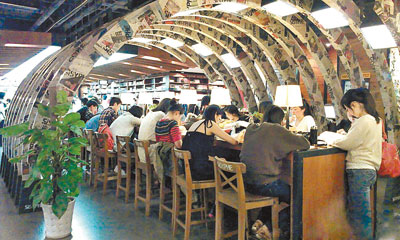 A FEW years ago many bookstores had to leave major shopping malls, as their decreasing sales meant they could not pay the high rent. This is changing. Many shopping malls and department stores are offering discounts and even scraping the rent for bookstores, viewing a bookstore as a draw for customers. In November, the Taiwan-based Eslite Bookstore opened an outlet in Suzhou, Jiangsu Province. The flagship store covers an area of more than 130,000 square meters, but only about 15,000 square meters are for books. Using only 25 percent of total area for books has been the practice of the bookstore for a long time. Positioning itself as a place for leisure activities, Eslite Bookstores have become popular in Asia. An Eslite outlet is set to open in Shenzhen next year. In November, Amazon, the world’s largest online bookstore, opened its first brick-and-mortar bookstore in the United States, and Dangdang.com, one of the largest Chinese online bookstores, announced plans to open 1,000 brick-and-mortar bookstores across the country within three years. The Sisyphe Books chain has already opened four bookstores in Shenzhen over only two years. “Buying books is no longer the purpose of going to a bookstore. A lot of people still buy books online, but they go there for a cup of coffee with friends, for pretty cultural products and for leisure activities,” a Shenzhen resident told a Chinese-language newspaper. Shenzhen Book City has embraced this model since the beginning. The bookstore organizes more than 800 cultural activities each year and it has become a popular spot for young people to meet and chat. According to statistics, the bookstore has about 8,000 to 10,000 visitors during weekdays and receives more than 30,000 visitors on the weekend. “When it just opened 10 years ago, I was a little disappointed as the book area was too small. There were too many different stores and restaurants. It was not what I expected at a bookstore,” a Shenzhen woman said. “I have to admit now that all these stores and restaurants are the reason that [Shenzhen Book City] can survive and grow.” Last year, Shenzhen Book City’s sales volume reached more than 500 million yuan (US$79 million). Publication sales accounted for about 30 percent and the rest were through stores and activities. In many major bookstores in Shanghai, book sales account for about 50 percent of total sales, while sales of cultural products and beverages account for 28 percent and 22 percent. Stores only make 10 to 30 percent profit on each book sold, while cultural products and beverages are sold at 50 percent and 75 percent profit respectively. Many bookstores have pushed the actual books into corners to make room for more profitable merchandise. For example, when Sisyphe Books opened its first store in Shenzhen at the 1234 Space in Luohu District in 2013, it had coverage of 400 square meters. The coverage increased to 450 square meters when it opened its third store at Coco Park, Futian District, in 2015, including a coffee shop covering an area of 100 square meters. When the fourth store opened in Shekou Garden City Center, Nanshan District, it changed its name to “Sisyphe Books & Up Coffee.” “Although only 20 percent of our business comes from the coffee shop and cultural products, the unique experience they offer has significantly helped attract more loyal customers,” said Jin Weizhu, president of the bookstore. “Bookstores nowadays are no longer just for people seeking knowledge. It serves people who have buying power and have spiritual pursuits.” This is also the strategy for the online stores’ offline expansion. “Dangdang.com is now planning bookstores. We plan to have stores at places such as city landmarks, airports and in residential communities, and we also plan to have stores in different styles, such as family stores, cultural stores and library-style stores. They can be independent stores and can also be in shopping centers,” said Mo Jun, an official from Dangdang.com. According to Dangdang’s plan, books sold at the brick-and-mortar stores will be the same prices as those sold online. The company will choose what books to stock based on computer analysis. “Our goal is to create a multiple cultural retailer using books and the cultural resources we have obtained over the years,” said Mo. (Wang Yuanyuan) | 
